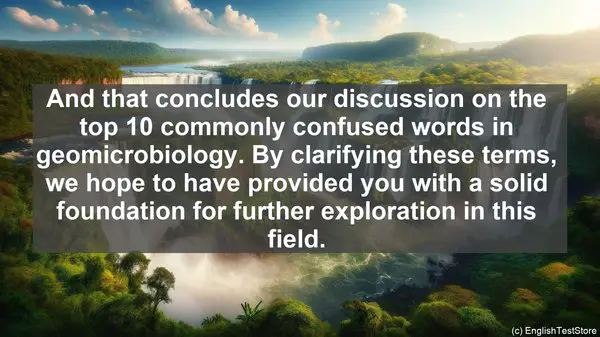Introduction
Welcome to today’s lesson. Geomicrobiology is a fascinating field, but it can be challenging, especially when it comes to the terminology. In this lesson, we’ll be discussing the top 10 commonly confused words in geomicrobiology. By the end of this lesson, you’ll have a better grasp of these terms and their nuances.
1. Biomineralization vs. Bioremediation
Biomineralization and bioremediation are two terms that are often interchanged, but they have distinct meanings. Biomineralization refers to the process by which microorganisms form minerals, while bioremediation is the use of microorganisms to remove pollutants from the environment. Understanding the difference between these two terms is crucial in geomicrobiology.
2. Aerobic vs. Anaerobic
Aerobic and anaerobic are terms used to describe the presence or absence of oxygen. In geomicrobiology, these terms are essential when studying microbial metabolism. Aerobic microorganisms require oxygen for their metabolic processes, while anaerobic microorganisms can survive and thrive in the absence of oxygen.
3. Autotroph vs. Heterotroph
Autotrophs and heterotrophs are terms that categorize organisms based on their carbon source. Autotrophs can synthesize organic compounds from inorganic sources, such as carbon dioxide, while heterotrophs rely on organic compounds produced by other organisms. These terms are crucial in understanding microbial food webs in geomicrobiology.
4. Syntrophy vs. Mutualism
Syntrophy and mutualism are two types of symbiotic relationships between microorganisms. Syntrophy refers to a relationship where two or more microorganisms work together, with one organism benefiting from the metabolic byproducts of the other. Mutualism, on the other hand, is a mutually beneficial relationship where both organisms gain from the interaction. These relationships play a vital role in microbial communities in various geomicrobial environments.
5. Chemotaxis vs. Phototaxis
Chemotaxis and phototaxis are terms used to describe the movement of microorganisms in response to chemical or light stimuli, respectively. Understanding these terms is crucial when studying microbial motility and their ability to navigate in their environment.
6. Biofilm vs. Planktonic
Biofilms and planktonic cells are two forms of microbial growth. Biofilms are communities of microorganisms attached to a surface, while planktonic cells are free-floating. Each form has its advantages and disadvantages, and studying their dynamics is essential in geomicrobiology.
7. Genotype vs. Phenotype
Genotype and phenotype are terms used to describe the genetic and observable characteristics of an organism, respectively. In geomicrobiology, understanding the relationship between genotype and phenotype is crucial when studying microbial adaptations to different environments.

8. Biogeochemical Cycling vs. Bioremediation
Biogeochemical cycling and bioremediation are two processes that involve microbial activities. Biogeochemical cycling refers to the cycling of elements, such as carbon, nitrogen, and sulfur, through biological, geological, and chemical processes. Bioremediation, as mentioned earlier, is the use of microorganisms to remove pollutants. While these processes are interconnected, they have distinct focuses in geomicrobiology.
9. Phylogeny vs. Taxonomy
Phylogeny and taxonomy are terms used to classify and understand the relationships between organisms. Phylogeny focuses on the evolutionary history and genetic relationships, while taxonomy involves the classification and naming of organisms. Both concepts are essential in geomicrobiology to understand the diversity and evolutionary relationships of microorganisms.
10. Metagenomics vs. Metatranscriptomics
Metagenomics and metatranscriptomics are two approaches used in studying microbial communities. Metagenomics involves analyzing the genetic material (DNA) present in an environmental sample, providing insights into the potential functions and diversity of the community. Metatranscriptomics, on the other hand, focuses on the analysis of the RNA, providing information about the active genes and metabolic processes. These approaches have revolutionized our understanding of microbial communities in geomicrobial environments.


